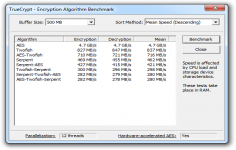 TrueCrypt 6.1
TrueCrypt 6.1
TrueCrypt Foundation - (Open Source)
Encrypting a USB key or a whole disk or even creating virtual encrypted disks, all these are possible with TrueCrypt.
TrueCrypt is a solution for storing encrypted information, allowing to create encrypted virtual disks. When mounted, the media appear in Explorer as a local disk. The application is also able to encrypt an entire volume or partition, which is very useful if there are sensitive information on the USB drive, for example. The encrypted volume is seen by the system as a typical hard and has all the features, being necessary only to enter the password associated with the volume at the time of "montage".
The software also includes hardware acceleration for encryption and decryption of AES algorithm. Enabled by default , this small revolution concerns only the recent Intel processors with the necessary capabilities : Intel Core i7- 980X , Intel Core i7 -970 , Intel Core i5- 650, Intel Core i5- 655K , Intel Core i5- 660, Intel Core i5 -661 , Intel Core i5 -670 , Intel Core i5 -680 and more, the speed of encoding and decoding being up to 8 times faster.
A volume can be mounted directly under Windows subject to provide the correct password. It is possible to create partitions and storage devices encrypted on the hard disk sectors with 4096, 2048 or 1024 bytes.
Many standard algorithms are supported by TrueCrypt, such as AES-256, Blowfish, CAST5, Serpent, Triple DES, and Twofish.
- Title:
- TrueCrypt 6.1
- File Size:
- 3.0 MB
- Requirements:
- Windows 2000 / XP / Vista / Windows7 / XP64 / Vista64 / Windows7 64 / Windows8 / Windows8 64
- Language:
- en-us
- License:
- Open Source
- Date Added:
- 01 Nov 2008
- Publisher:
- TrueCrypt Foundation
- Homepage:
- http://www.truecrypt.org
- MD5 Checksum:
- 2DA0A448DB5AA4E4770AECBF0357E008
New features:
*
Ability to encrypt a non-system partition without losing existing data on the partition. (Windows Vista/2008)
Note: To encrypt a non-system partition in place, click 'Create Volume' > 'Encrypt a non-system partition' > 'Standard volume' > 'Select Device' > 'Encrypt partition in place' and then follow the instructions in the wizard. Please note that this is not supported on Windows XP/2000/2003 as these versions of Windows do not natively support shrinking of a filesystem (the filesystem needs to be shrunk to make space for the volume header and backup header).
*
Support for security tokens and smart cards (for more information, see section Security Tokens and Smart Cards in chapter Keyfiles).
*
The TrueCrypt boot loader can be prevented from displaying any texts (by selecting Settings > System Encryption and enabling the option 'Do not show any texts in the pre-boot authentication screen').
*
The TrueCrypt boot loader can now display a custom message (select Settings > System Encryption and enter the message in the corresponding field) either without any other texts or along with the standard TrueCrypt boot loader texts.
*
Pre-boot authentication passwords can now be cached in the driver memory, which allows them to be used for mounting of non-system TrueCrypt volumes (select Settings > System Encryption and enable the option 'Cache pre-boot authentication password').
*
Linux and Mac OS X versions: The ability to mount a Windows system partition encrypted by TrueCrypt and to mount a partition located on a Windows system drive that is fully encrypted by a Windows version of TrueCrypt.
Improvements:
*
Protection against memory corruption caused by certain inappropriately designed versions of some BIOSes, which prevented the pre-boot authentication component from working properly.
(Windows Vista/XP/2008/2003)
*
During the process of creation of a hidden operating system, TrueCrypt now securely erases the entire content of the partition where the original system resides after the hidden system has been created. The user is then prompted to install a new system on the partition and encrypt it using TrueCrypt (thus the decoy system is created).
Note: Although we are not aware of any security issues (connected with decoy systems) affecting the previous versions of TrueCrypt, we have implemented this change to prevent any such undiscovered security issues (if there are any). Otherwise, in the future, a vulnerability might be discovered that could allow an attacker to find out that the TrueCrypt wizard was used in the hidden-system-creation mode (which might indicate the existence of a hidden operating system on the computer) e.g. by analyzing files, such as log files created by Windows, on the partition where the original system (of which the hidden system is a clone) resides. In addition, due to this change, it is no longer required that the paging file is disabled and hibernation prevented when creating a hidden operating system.
*
Many other improvements. (Windows, Mac OS X, and Linux)
Bug fixes:
*
Many minor bug fixes and security improvements. (Windows, Mac OS X, and Linux)
Related software
2.2/5 from 179 users


